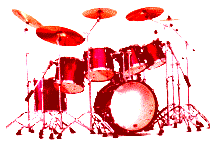
 School of Drums
School of Drums
It seems that every drum book and instruction method
will cover these topics very well. I tend to automatically
assume that students will get this info just about anywhere
they may look. I really may be wrong to think that way.
Stick holding techniques occasionally cause considerable
debate amongst students and educators alike . . . I like to avoid debates. Keep your mind open on all this. My own opinions are just
that. Opinions! I don't wish to argue or debate with the World.
This is just my own personal viewpoint. Some of us tend to view the forest from above while
others prefer to examine the bio-structure of every blade of grass
on the forest floor. "To each, their own".
With the match grip, we occasionally use the fingers to
manipulate the sticks. It all depends on the type of maneuver
being employed.
On other occasions, all but the thumb and first
(index) fingers may be removed to achieve a 'crush' or 'press'
effect. This is done by griping the stick tightly between the
thumb and first finger (only) then striking the drum, producing
multiple 'buzz" of notes with one movement of the hand. When this is done
with both hands in rapid repetition, a 'buzz' or 'crush' roll
can be achieved. As speed develops, this will equate to 'crushing'
doubles, though the actual movement is a SINGLE (crushing) stroke
with each hand. The angle of the palms is arbitrary, depending on the maneuver
being employed. As we traverse the drum kit, palm angle
will vary considerably. It will come natural! Don't worry
about all that . . . just play . . . and play a lot! The
more we play the more our own natural coordinating abilities
will kick in . . . we won't need to even think about it.
The human mind will find the easiest and best way for us
as individuals, to make the moves. The secret is in playing,
and playing a lot. Get into playing with recorded music and
focus on that FUN factor! Play for hours on end! The muscle
development will occur automatically with very little
attention to detail. Different drummers throughout pop music history have developed
their own unique methods of holding the sticks. It didn't inhibit
their success as drummers. In fact . . . in some cases . . . their
unusual gripping techniques may have contributed to their
personal fame and fortune. Keith Moon, who is accepted by most people as one of the
top 10 'all time' rock drummers, made a terrific example of this
point. I could never feel comfortable with his personal method
of holding the sticks, but it didn't seem to hold him back. Keith tended to hold both sticks at the very end (or butt) of the stick.
He simply pinched the very end of the sticks with the thumb and index
finger. I don't know how he was able to play anything that way,
but it worked for him. This lends credence to the fact that it apparently may not matter HOW we hold the sticks.
What seems to matter most is what we can DO at the kit; 'OUR WAY'! Kieth's
example underscored for me the fact that we (our individual minds')
will assist brilliantly as we continually play. Sometimes we develop in ways
that set us apart from the sheep. Kieth's unique approach to gripping
the sticks may have been a contributing factor to his legendary success.
TRADITIONAL GRIP: HISTORY OF THE TRADITIONAL GRIP: Drum sets were not created or invented until about 1840.
The first drum set drummers were of course, marching drummers
initially in the 1600s and probably before. It took 120 years for our brilliant (traditional) educators to accept
any other method of holding the sticks. The traditional grip
was set in stone and it wasn't to be discussed, haha. This
doesn't say much for the general logic or common sense of
our (traditional) educators! Sometime between 1955 and 1965 . . . the lights began to go
on! In the mid-1960s Ringo Starr (with the Beatles) made
several million dollars while holding a match grip. The
stuffy old drum teachers were forced to ponder the issue a little
deeper, (myself included . . . blush, blush). It took a few
years of debate, but I think in the final analysis in. All but
a few die-hard old fogies have finally accepted the 'Match
Grip' over the 'Traditional Grip', if we are playing on a
full drum set with the snare drum positioned lower and
almost flat in front of the player. However; the traditional grip has its merit too. It doesn't
hurt a thing to utilize both methods. I do that myself.
At the same time, I tell all my young students to put the
traditional grip aside for a rainy day . . . and get on
with the job at hand. Make some music first and worry
about the small stuff later! Use the 'match' grip if it feels
more comfortable. At this point in time (2014), 95% of all the top working drummers
tend to favor the 'Match' grip. I'm in total agreement myself, though
I may still favor the 'Traditional' grip, simply because I was taught that way. Some PARADE drummers may still need the old Traditional
grip, if they are marching and playing with a snare drum slung over the shoulder,
(the old way). Otherwise; almost every drummer uses the match grip, these days. SOUTH-PAWS: (Left handed students) Many left handed students want to reverse the traditional
grip along with everything else. That's ok if it works for you
but this drum instructor recommends against it. Just use the
match grip and move on. Hold both sticks the same way. While we are on this (South-Paw) subject though, it may be
good to touch on another issue of importance to left-handed
students . . . Left-handers who re-arrange the hi-hat to the right side
of the kit need to experiment with a more acceptable way.
Re-arranging the kit can be hazardous to your career for
less than obvious reasons . . . It often occurs that we must jump onstage and audition
for potential jobs, using another drummer's kit. A right-handed
drummer will rarely appreciate it if we re-arrange their drums.
Many will often say, "ABSOLUTELY NOT" to this very inconsiderate action.
Also, changing drums around takes time. Usually the band onstage is
under pressure to keep things moving. They simply want us to get on stage and begin playing
immediately! There often may be no time to make the changes. You
may wind up in the uncomfortable position of auditioning
and playing on a backwards rig at the same time. Not cool! WHAT'S A SOUTH-PAW TO DO? Many of todays left-handed drummers have discovered a
better way to be left handed. They set up their kit in the normal
right-handed fashion and simply play the hi-hat with their
left hand and their snare with the right. This is opposite from
a right-handers technique. They DO play the bass with their right foot and work the hi-hat
pedal with their left just like a right-handed drummer though.
This unique way of playing will mesmerize any and all right-
handed drummers. The left-hander using this style will often
rise to the top quickly because it is so logical, practical
and unique. Carter Beauford with the Dave Matthews Band is a prime
example of a very hot drummer using BOTH techniques. (I think
Carter was voted drummer of the year in 1997 by Modern Drummer
Magazine.) Check him out . . . especially if you are a south-paw.
He is amazing to watch because he seems to play just as well left-handed as
he does right-handed. I admire that completely! (I've worked at it, but I can't do it effectively.) Yes, I do cry about it; A LOT! :) LOL! A debate has raged for decades concerning the BEST way
to attack the bass drum and hi-hat pedals. Common sense
should prevail here. This is my opinion . . . you are entitled
to your own. TOE KICK: I advocate this method of attack even though I originally
learned using the 'Heel Down' method. (See below.) Yes! I feel this 'Toe-kick' is probably the very best way to play.
However, it is still only my opinion. HEEL DOWN: With the heel-down method . . . we scoot back a little, keeping
the shin at an angle (approximately 75*) and the foot remains
flat on the pedal. This uses the calf muscles. Some power may be
lost by using this method. Try both methods, you will feel
the difference! Go with the one that suits you. It really doesn't
make that much difference. Many of the world's greatest jazz players have used this 'Heel Down'
method of attack for years. You would never think they were operating
at a handicap by using the 'heel down' method, even if common sense
does dictate otherwise. Some volume and power is lost with this method of kick, but
how often do we hear complaints that the bass drum isn't loud enough? Besides that,
a microphone placed inside the bass drum will raise the volume to any additional volume that may be needed.
Tests have fairly well proven that near equal speeds will arrive (sooner or later) with either method of kick. Speed
with bass drum techniques is predominately governed by the drummer's (eventual) mastery of Bass Syncs and variations. Again . . . as a final thought . . . it is best to use
the methods that work best for you.
Musical Time - Finite to Infinity: Finite to Infinity: Discover the (lost) 500 year-old enigmatic secrets hidden within
the current time-signature system. Seven short mesmerizing and easy-to-follow lessons will lead you quickly and easily towards
(musical-time) guru status. You will learn to visualize (read, write or feel) the existence This should lead
directly to the e-book. This very informative little booklet will amaze you
with hundreds of valuable tips and insider secrets! HOW TO: Purchase old/used drumsets for pennies and resell them for decent
profits.
![]()
![]()
![]()
![]() HOLDING THE STICKS,
HOLDING THE STICKS,
![]() ATTACKING THE PEDALS,
ATTACKING THE PEDALS,
![]() AND
AND
![]() TIPS FOR LEFTIES.
TIPS FOR LEFTIES.
![]() HOLDING THE STICKS . . .
HOLDING THE STICKS . . .
MATCH GRIP:
The 'Match Grip' is currently considered the best and
easiest way to grip the sticks if we are behind a standard
drumset. Simply imagine the drum stick as a hammer and we
want to drive a nail with it. Hold both the right and
left hand sticks the same way . . . so that they 'match'.
(That's why we call it a 'match' grip.)
Nearly every book on the market will show this method of
gripping the sticks.
The right hand stick is held 'like a hammer' as with the
'Match Grip' . . . but the left hand is different when using
the 'Traditional Grip'. Think of the left hand drumstick
as a pen or pencil . . . except . . . you will place two
fingers on top of the stick shaft and two fingers below the
stick shaft. The butt of the stick will lay into the crotch
or fleshy area between the thumb and first finger.
The traditional grip originated with marching drummers
who were playing a snare drum slung over the shoulder on a strap.
The angle of the drum required the drummer to reach around
the drum with the left hand and grip the stick differently. The
'Traditional Grip' was born at that time. The 'Match Grip'
wasn't feasible in this very awkward and different marching
situation. The Traditional Grip originated sometime during the
1500/1600s.![]() ATTACKING THE PEDALS
ATTACKING THE PEDALS
![]() (Toe-Kick VS Heel-down.)
(Toe-Kick VS Heel-down.)
We scoot in closer to the pedals so that the shin is at a 90*
angle to the floor. The heel is raised and the ball of the
foot (only) connects with the pedal. This method of attack uses
the full weight of the leg which allows for more power and speed.
The (stronger) thigh muscles are also used extensively.
All the older 'jazz' players were big on this method of attack.
I am still more comfortable with this method myself, even though I wish
I had learned the toe-kick from the beginning, (1950's).
BEGINNERS: Take the . . . DRUMMERS APTITUDE TEST, now!
![]() Copyright
Bill Powelson 1965-1994-2008-2014 @ all rights reserved.
Copyright
Bill Powelson 1965-1994-2008-2014 @ all rights reserved.![]()
![]()
Cool Drum Solos.
Video Drum Solo Lessons Free

Drum Solo Video: Click to 'LEARN' Watch and Learn Now! PLAY Great Drum Solos within hours (not years).
NEW 'Subliminal Method' teaches drum solo techniques PAINLESSLY!
Master rudiments 'NATURALLY' without boring regimentation or serious discipline.
Listen, watch and PLAY your way to awesome drum solos (and polished rudiments) BY SIMPLY HAVING FUN. . . . It works, folks!
Don't be a skeptic until you at least try it first. You owe it to yourself toTRY IT RIGHT NOW!
![]()
![]()
Membership Includes
EVERYTHING FREE! All the E-book icons are "hot" here at the password site. Click an e-book icon and go directly to the product.
Bill Powelson's Other Drumming Courses
![]()
